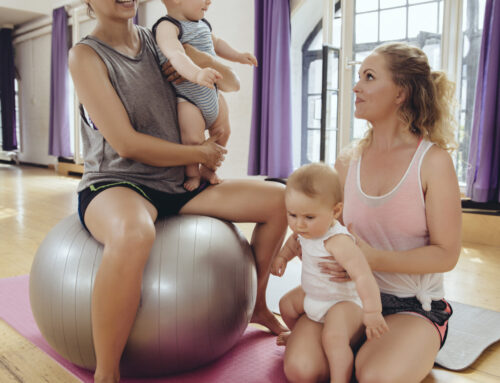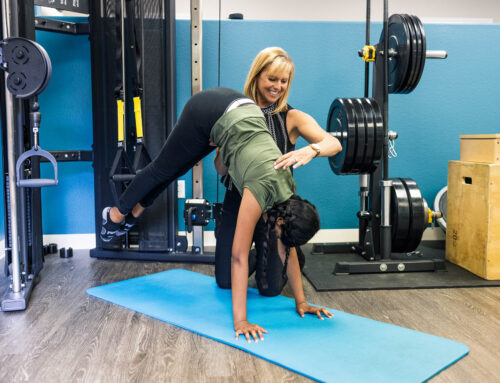By Dr. Sarah Martinez, DPT
As a physical therapist in Reno who works with many pregnant patients, I often get asked about exercise during pregnancy. The most common questions patients ask are what exercises are safe to do, and what exercises should I be doing to prepare for labor? Patients are also often misinformed that exercise can be harmful to their pregnancy when in fact it can be incredibly beneficial. So, let’s get into the benefits; what to watch out for; and how to stay mobile and active during your pregnancy.
Benefits of Exercise During Pregnancy
It is ideal to exercise four to five days a week for 20 to 30 minutes throughout your pregnancy. There are many benefits to exercising when you are pregnant. It improves blood pressure as well as overall strength and fitness levels. Exercise in pregnant women reduces chances of gestational diabetes or can help manage gestational diabetes if you have the condition. Back pain is also reduced with exercise, and that strength and mobility you gain through regular movement can help with delivery. Also, regular exercise helps keep the digestive tract healthy and prevents or eases any constipation issues.
Every pregnancy is different and unique. Just because something works for one person doesn’t mean it will work for another. When you are pregnant is NOT the time to start training for a marathon if you haven’t been running prior. It is also not the best time to start getting into intense CrossFit or other programs if you had not been doing it prior to getting pregnant. Exercise can be wonderful during pregnancy but keep it realistic to you!
Top 3 Exercises for Pregnant Patients
Clam Shells
Named for the way your legs and hips resemble a clam shell when performing the movement, this exercise will strengthen your hips and thighs while also stabilizing your pelvic muscles and toning your glutes.
Squats
You can vary the speed, depth or weight in a squat to make it challenging for you, but the most important part is keeping the form. Doing proper squats is an excellent way to build strength in your legs and glutes.
Bridges
Bridges are a fantastic way to work your glutes and hamstrings. This video shows you several ways to do a bridge workout depending on the intensity and difficulty you want for your fitness level.
Common Misconceptions About Exercise During Pregnancy
Unless you have a high-risk pregnancy, the likelihood of exercise hurting your growing baby are very low. High-risk pregnancies include conditions in Mom like cardiovascular or lung issues, preeclampsia, or high blood pressure. High-risk can also be any complications with the fetus that your OBGYN may have identified. If these issues are not present, then risk of injuring yourself or your unborn baby while exercising are not worth the worry. In fact, exercise helps you to have a healthier body and therefore healthier pregnancy.
Here are three of the most common misconceptions among healthy pregnant women when it comes to exercise:
1. I have to back off my normal exercise routine.
As long as you have a routine that works for you and you feel good doing it while pregnant, there is no need to “back off.” Listen to your body and if you feel good after a workout, keep doing it! If you get later in your pregnancy and fatigue easier or have aches in your back, then you can go lighter, but no need to preemptively change your workout routine.
2. I can no longer run.
Misinformation that running or higher impact exercises cause miscarriages are false. Especially if you are already a runner. If your body likes running and you feel good doing it, there is no need to stop because you are pregnant.
3. I can’t lift heavy.
Lifting heavy is not harmful to you or your baby. If you already lift weights, there is no reason to stop because you are pregnant. In fact, continuing to build those muscles keeps you strong and your core engaged, which helps with posture and can help you avoid lower back pain in that third trimester.
Safety While Working Out During Pregnancy
In general, low impact is a safe choice when pregnant, however whether it’s the best choice depends on the person and how their pregnancy is developing. In a healthy pregnancy, if the patient was already very active, they are generally OK to continue with their workout routine (lifting, running, swimming, etc.), though may need to modify technique and form as their pregnancy progresses.
If you feel overly fatigued, have muscle soreness or strain lasting more than two to three days, or pain beyond just soreness, you may have “overdone it.” If this happens, there are several things you can do to recover.
- If the pain and soreness is mild, then you will want to rest and ice the area. When you are feeling better, consider changing the workout to not be so strenuous. For example, change the amount of weight you are lifting or adjust the height and angle of the movement.
- If the discomfort is more moderate, then a prenatal massage may do wonders. You can also book a physical therapy appointment or see a prenatal chiropractor. All of these modalities can help more severe muscle or alignment issues.
Make sure to schedule rest days into your workout routine. These can include a 20-to-30-minute walk, doing prenatal yoga, or getting a prenatal massage.





